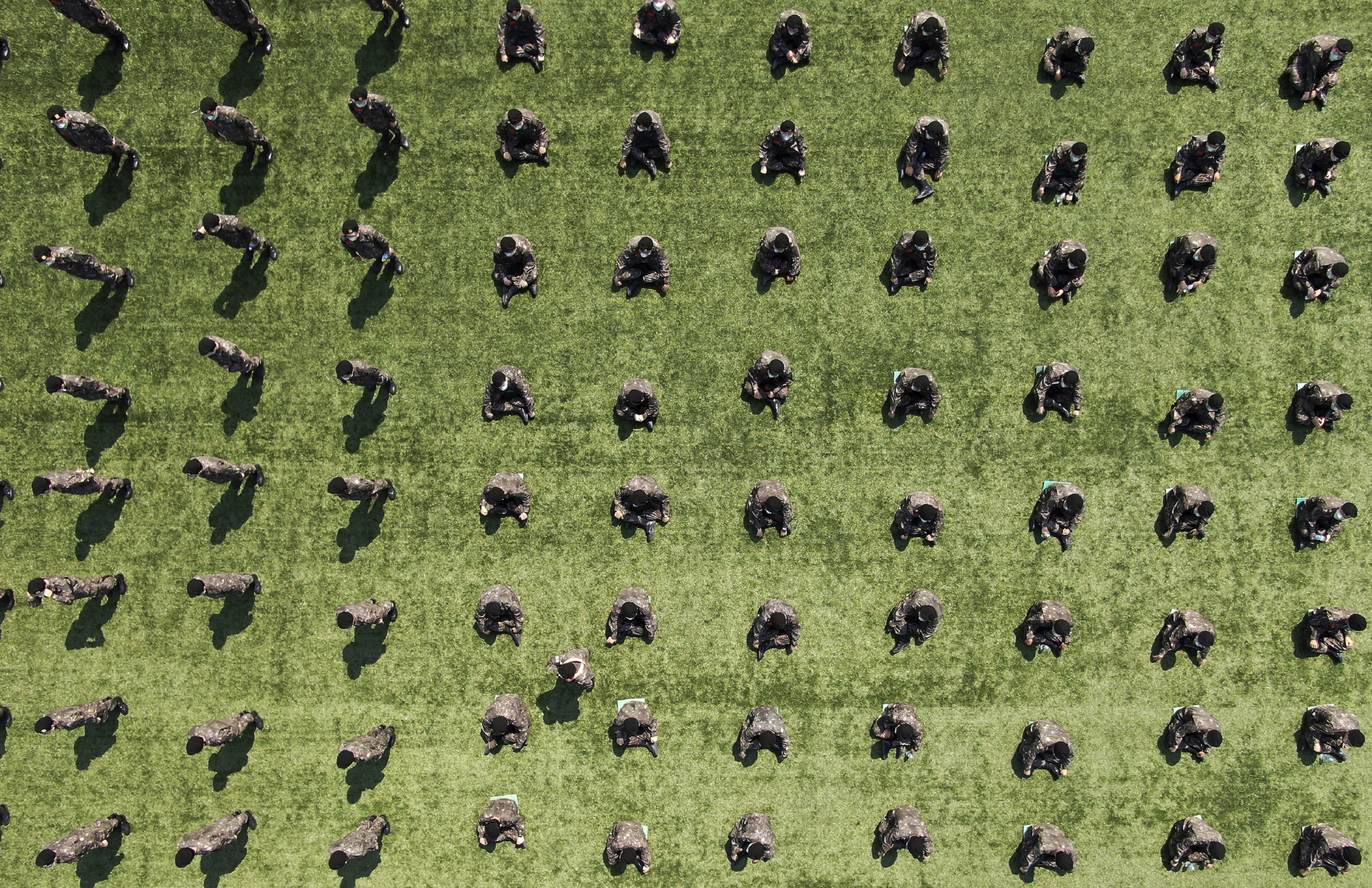When the pandemic hit Western liberal democracies, it found countries in need of profound institutional reform. For the past 14 years, democratic frameworks have been weakening and receding, with many countries experiencing an erosion of individual rights and civil liberties. It was in this context that the coronavirus erupted and within a few weeks, every aspect of reality was transformed, with core democratic expressions like voting or protesting becoming a potential threat to public health.
The combined forces of democratic crisis and COVID-19 have presented the world with a historic opportunity to profoundly rethink the way governments operate. The inertia of the status quo — a major obstacle for those trying to innovate — suddenly lost its implacable force, and we became more compelled than ever to think of alternatives.
It’s about time. Despite the internet transforming every aspect of how we live, somehow our political institutions have remained mostly unaltered by the past two decades of advances in information technology. A representative democracy with elections held every few years is a system designed in the 19th century and based on 15th-century information technology, the printing press. This was a great model for a time when communication was done through paper and ink, but it falls short in addressing the needs of our highly interconnected societies.
“New political orders have always had a symbiotic relationship with new technologies.”
Looking at the global democratic recession and possible connective tissues behind country-specific circumstances, the effects of technological disruption emerge everywhere. Jobs are being automated and work is becoming more precarious — and adding chaos and confusion to the widening gap between those who benefit from globalization and those excluded from it is social media that further polarizes constituencies and enables (by design) campaigns of psychological manipulation.
Thus, in navigating our way forward, it is imperative that we understand how technology can serve humanity — all of humanity, not just a small elite.
Getting to this point necessarily involves creating paths for a plurality of voices and perspectives to emerge. But what should a democracy look like in the internet era? One of the obstacles that hampers our ability to move forward is that imagining positive narratives around technology is a challenge in and of itself. Most of our science fiction is dystopic. And with few exceptions, these cautionary tales have served well to avert us from effectively employing technology-enabled coordination solutions in our governments. Luckily, there are a few real-world examples that can point the direction, revealing the extraordinary possibilities that emerge when digital connection is employed for improving governance.
#TaiwanCanHelp
Over the past few months, Taiwan has provided a prominent example of the power and effectiveness of online participatory practices in addressing the coronavirus crisis. Taiwanese democracy was born concomitantly with the internet, a historical coincidence that helped it develop perhaps the strongest civic technology ecosystem in the world. Citizens are technologically savvy and engaged. The government is cooperative and responsive.
Taiwanese public health officials learned about coronavirus in December 2019 through a Reddit-like forum, and took the potential danger seriously enough to start assessing travelers arriving from mainland China. Needless to say, it paid off. At the outset of the pandemic, the Taiwanese government leveraged the collective intelligence of the country’s residents to propose, vote, design and implement a series of applications that helped them accurately map the spread of contagion and manage the supply of masks around the country. Abundant and precise information, voluntarily shared by citizens, enabled a set of surgical responses that avoided a state-wide lockdown and economic freeze.
Taiwanese democracy is not restricted to electing representatives every few years. It’s a continuous exercise of broad social coordination supported by digital connection. Feedback loops with the population are dynamic, and institutional responses are prompt. A platform called vTaiwan is continuously employed to surface citizen-led proposals and allow people to debate political measures, helping the country legislate with the collaboration of its constituents. When Uber arrived in Taiwan, for example, thousands of participants helped build a consensus on how to regulate the company and its drivers and workers.


Sustaining these participatory practices is guaranteed broadband internet access, subsidized by the state for over 98% of its citizens. Any family not covered can take their request directly to the country’s digital minister, the mesmerizing hacktivist Audrey Tang, who has publicly committed to ensuring universal access. Furthermore, instead of digital literacy, Taiwanese schools teach digital competency: “When you say literacy, you assume that they are consumers of data. When you say competence, you assume they are producers of data,” Tang has said. “Competence is what we want from a population because everybody is co-creating democracy together.” This means citizens are equipped with the necessary skills to quickly prototype new governmental platforms or additional features for existing ones, and they often do. The government in turn provides the necessary resources to continuously analyze and implement those initiatives, a process called “reverse procurement.”
Yet, perhaps the most interesting of the Taiwanese government’s innovations is a fairly low-tech one: developing expertise in producing and strategically sharing memes. Public policy in Taiwan meets citizens where they are, on social media, and uses humor to convey factual information and spread clarity. This has been incredibly successful in keeping the populace calm and collected during the pandemic; more critically, it has prevented significant misinformation from gaining traction, squashing rumors, conspiracy theories and divisive stories. Often, to dispel fake news, all it takes is for government channels to publish humorous viral memes. It’s hard to laugh at something and feel scared at the same time.
Governance Beyond The Nation-State
Thinking about democratic innovations necessarily brings an observer outside the strict scope and boundaries of the nation-state. Political movements and phenomena are increasingly transnational, and here borderless blockchain networks offer promising technologies for innovative governance.
Criticisms of online voting abound, with the main vulnerability being that at the end of the day, whoever controls the voting software gets to control results. This leads to a very old question, first formulated by the Roman poet Juvenal in the second century: “Quis custodiet ipsos custodes?” Who watches the watchmen?
Paper voting addresses this issue by requiring that members of the different parties involved in an election are present when votes are counted, so one essentially watches the other. While that may be a stable procedure in most developed nations, vote-counting is often marred by violence and threats in countries without robust legal systems. Providing a better alternative to this physical multiparty verification is precisely the raison d’être of blockchain technology, which specifies a set of incentives for a network of participants to maintain a decentralized and censorship-resistant ledger. Think of a Wikipedia-like structure, properly incentivized to ensure there’s no fraudulent behavior within its network.
“Who watches the watchmen?”
It is still too early to begin implementing this technology in elections, with many more advances in cryptography techniques needed to ensure that robust secrecy and anonymity is provided to voters. That said, these networks can already offer a glimpse of what’s possible in terms of digital governance, since in many ways their functioning is analogous to nation-states. Both have a common currency and public goods that require funding and maintenance. The key difference is that “citizens” of blockchain networks are distributed around the globe, and the dominating ethos of those communities is one that favors disintermediation and participation over central planning. In order to achieve that, various solutions are being pioneered. In fact, a kind of political-economy Renaissance is taking place, and rapid experimentation with new institutional frameworks and economic and political designs is occurring at an accelerated pace.
Among the most prominent innovations is “quadratic funding,” a collaboration between Microsoft’s political economist Glen Weyl, Ethereum’s creator Vitalik Buterin and Zoë Hitzig, a poet and economics PhD student at Harvard. Quadratic funding consists of a matching mechanism that helps surface and distribute resources for public goods. Similarly, quadratic voting is a system that helps increase the diversity of decision-makers by empowering smaller groups to make their voices heard with a pricing mechanism that accurately signals whether the strong preferences of a minority outweigh the weak preferences of a majority. There are also decentralized autonomous organizations where members pool funds and vote on how to allocate them with governance rules that are formalized and enforced by smart contracts running on a blockchain.
In addition to decentralized networks, these different solutions are already being experimented with by forward-looking governments. For example, in 2019, the legislature in Colorado had to allocate $40 million over 100 different bills, but struggled with self-interest voting, given that most legislators were sponsoring many of the bills. After experimenting with different mechanisms without success, they decided to give quadratic voting a shot. “There was a pretty clear signal on which items, which bills, were the most important for the caucus to fund,” said Rep. Chris Hansen, who helped spearhead the initiative. Now the executive branch is using the same mechanism to facilitate decision-making among its different offices.
“As we carve new paths and create new futures, few things are more important than building a democracy fit for the interconnected citizens of the 21st century.”
RadicalxChange Foundation, a nonprofit dedicated to reimagining the building blocks of democracy and markets, as well as popular organizations in the blockchain space such as Democracy Earth and Gitcoin, are pioneering these new methods and collaborating with governments to facilitate and spread the word about these emerging social technologies. Such innovations can be profoundly helpful with the endemic crisis of representation being experienced by traditional institutions today. Serving as a sandbox for political innovation, blockchain networks may facilitate experimentation for governments, where decisions involve considerably higher risks.
New political orders have always had a symbiotic relationship with new technologies: Think of the role of the printing press in the birth of nation-states, allowing humans to stop writing in the language of old power, Latin, and use their own vernacular idioms instead, linking nearby regions and allowing for common discourse. Or, conversely, think of how the internet was created as an American military defense strategy during the Cold War: Researchers with DARPA — the Defense Advanced Research Projects Agency — discovered that storing information over peer-to-peer networks instead of central mainframes would help protect American secrets, rendering any nuclear attack from the Soviets pointless.
Similarly, we are experiencing an inflection point in history, one in which the intersection between governance and technology is already transforming our existing institutions, one that may birth new political orders and entities. The explosion of information enabled by the internet is bringing a Copernican twist in how we understand ourselves as humans, organizations or nations: We are empowered, creative agents, but also interdependent nodes operating in a network. As we carve new paths and create new futures, few things are more important than building a democracy fit for the interconnected citizens of the 21st century — one that can extend to, include and empower each and every one of us.





